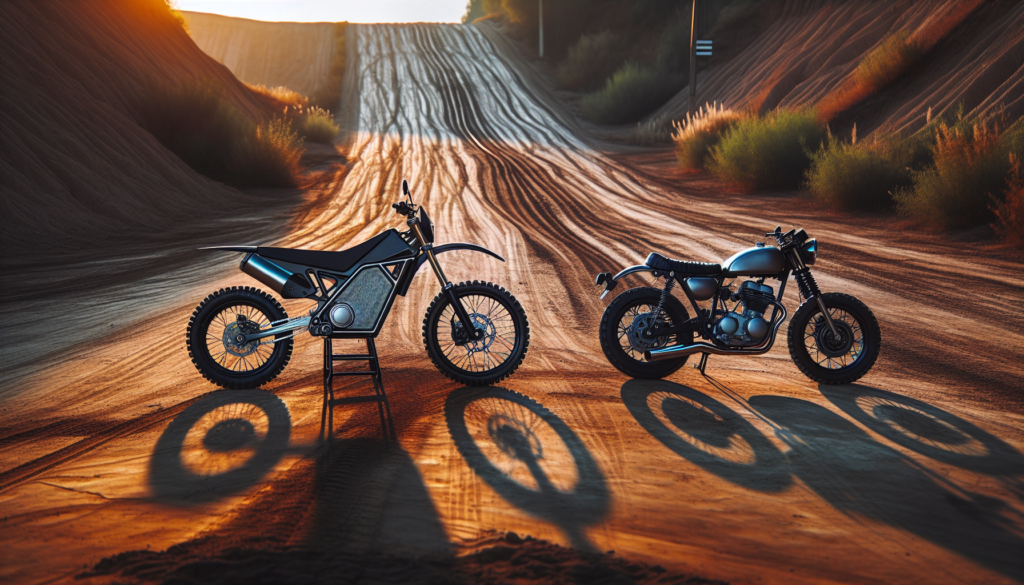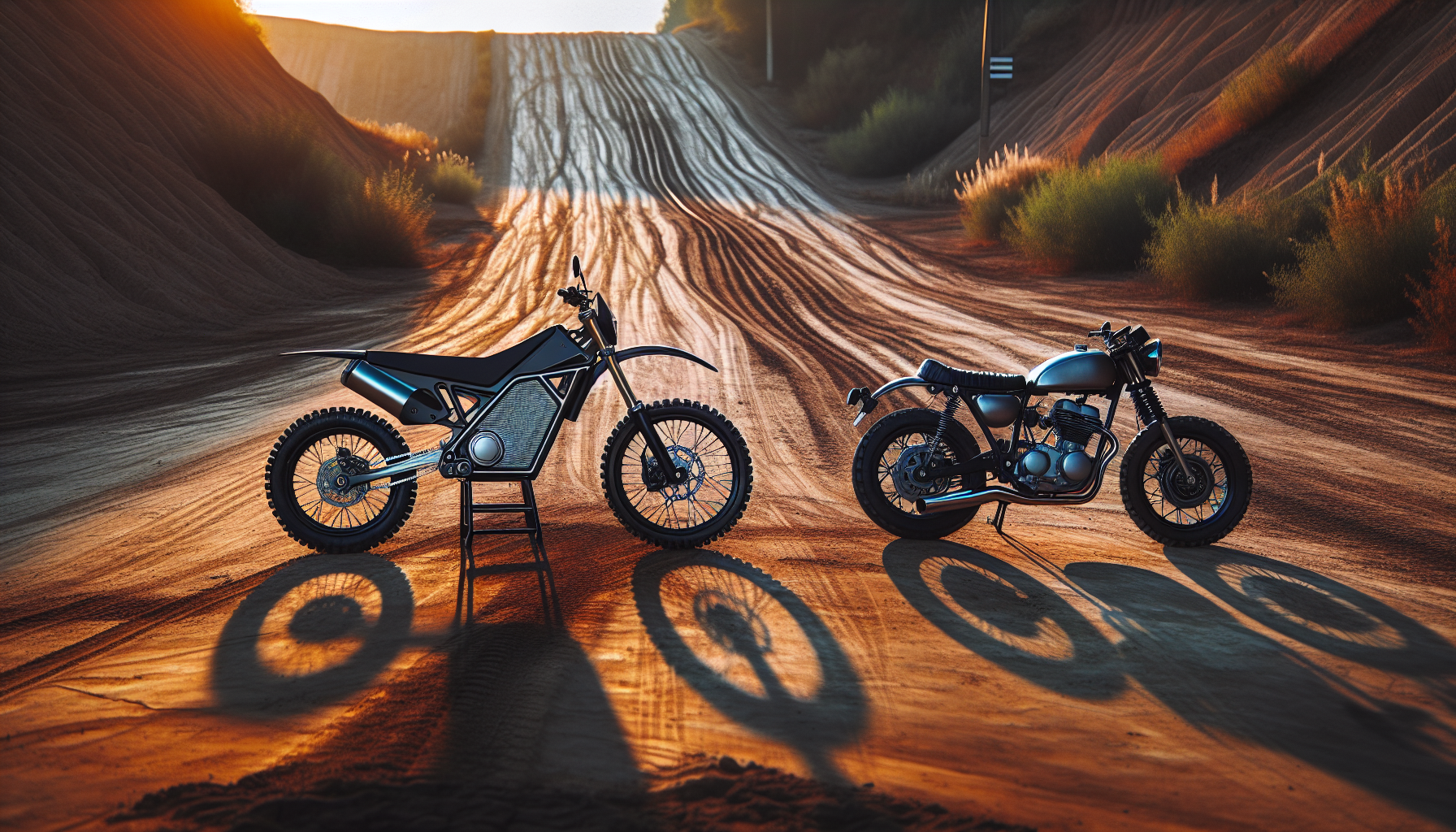Venturing into the rugged terrain of motorbiking, the debate between electric motorbikes and their gas-powered alternatives burns as fiercely as the trails they traverse, with enthusiasts of off-road vehicles passionately defending the merits of their preferred machines.
Electric motorcycles are often praised for their lightning-quick acceleration due to instantaneous torque delivery.
Although they may not quite match the top-end speed of their competitors, they provide a nimble and responsive ride, a quality highly prized by off-road enthusiasts.
Comparatively, gas-powered motorbikes exhibit a broader power band, demanding rider skill to harness their high-revving engines. This traditional power train offers a familiar roar that some purists argue is part of the off-road experience, unlike the quiet hum of electric motorcycles that is changing the soundscape of the trails.
Click here to learn more about: dirtbikevault.com
Type of Dirt Bike for Off-Roading
When setting out for an off-road adventure, the selection of a motorized companion involves more than just choosing between the roar of an engine or the quiet hum of a motor; factors like the ruggedness required for motocross and the versatility desired for dirt biking also play crucial roles in the decision-making process. In the realm of dirt biking, especially when venturing into uncharted terrains, the choice between electric and gas-powered engines is pivotal.
Electric dirt bikes offer the appeal of eco-friendliness, featuring a power train devoid of the emissions that accompany gasoline-powered models.
This attribute is becoming increasingly significant for motocross enthusiasts who are mindful of their environmental impact.
Traditional bikes require riders to master the use of the clutch and throttle to manage the demanding power output. In contrast, electric dirt bikes stand out with their seamless power delivery, which can be particularly appealing to newcomers and seasoned riders alike. The maintenance narrative for electric models also diverges; they eliminate the need for frequent oil changes and air filter replacements that are common in the world of motocross and dirt bike racing.
Advantages of Electric Dirt Bikes
As the off-road landscape evolves, motorcycles powered by electricity are forging new paths, signifying a future where the exhilarating sport of dirt biking is powered by innovation and environmental consciousness rather than gasoline; amid this shift, electric-powered bikes and their gas-powered counterparts are being juxtaposed in a growing number of dirt bike comparisons, highlighting the benefits and trade-offs of each technology. These silent yet formidable machines mark a significant departure from traditional off-road vehicles.
At the core of these motorcycles is a suite of advanced technologies.
Robust batteries and efficient electric motors deliver power with a smoothness that challenges traditional bikes.
Riders can anticipate continuous enhancements, including improved battery life, which highlights the stark differences in the dirt bike comparison arena when compared with their combustion-engine counterparts. The convenience of recharging by simply plugging in underscores the appeal of electric-powered bikes for the eco-conscious rider.
Benefits of Gas-Powered Dirt Bikes
Amidst the symphony of the wild, the visceral growl of gas-powered dirt bike brands offers a sense of raw power that is unmatched by the quiet operation of their electric counterparts, yet the electric dirt bike models bring innovative features such as instant torque and zero emissions to the adventurous rider. Riders who prefer these traditional motorcycles appreciate the immediate throttle response unique to gas engines, which is essential for navigating the unpredictable terrain of off-road trails.
This characteristic rush of acceleration satisfies adrenaline enthusiasts and provides the precision necessary to tackle challenging obstacles.
Refueling a gas-powered dirt bike is a quick process, a crucial advantage when adventuring in remote locations where electricity may not be readily available.
The convenience of topping up the tank at any roadside station lends invaluable peace of mind, ensuring that the ride continues as long as the rider wishes. In contrast, riders of electric dirt bike models may experience a significant difference in downtime between rides due to longer charging times. Beyond the sleek designs of electric dirt bike models, it is their whisper-quiet operation and instant torque that truly distinguish them from their gas-powered counterparts.
Comparing Electric and Gas-Powered Dirt Bike Performance
In the ever-evolving debate between electric and gas-powered dirt bikes, performance nuances are critical, especially when considering the instant torque and silent operation that highlight the electric dirt bike performance advantages over traditional gas-powered models. Electric bikes, lauded for their eco-friendliness, offer a quiet ride and a reduced carbon footprint, allowing riders to merge seamlessly with the wilderness.
Their zero emissions support a sustainable future, aligning with the values of environmentally conscious riders.
On the other side of the track, gas-powered dirt bike benefits include leading the race in endurance.
With the ability to traverse extensive distances on a single fuel tank, they cater to adventurers aiming for prolonged excursions without the stress of finding charging outposts. These bikes also present a hands-on maintenance culture that many purists relish.
It’s not merely about the ride but the relationship between rider and machine, with a maintenance ritual that deepens this bond.
Electric vs Gas-Powered Dirt Bikes: Key Points
- Electric dirt bikes provide instant torque for quick acceleration.
- Gas-powered dirt bikes can cover longer distances on a single tank compared to the current range of electric bikes.
- Electric models offer a silent ride, which is less disruptive to wildlife and the natural environment.
- Maintenance of gas-powered dirt bikes offers a traditional, hands-on experience valued by many enthusiasts.
Features to Look for in an Electric Dirt Bike
As an adventurer speeds over varying terrain on an electric dirt bike, they experience firsthand the advantages of modern battery technology that powers their ride, such as the instant torque delivery and quiet operation that allows for an immersive journey through the wilderness without disturbing the natural harmony. Compared to traditional gas-powered models, electric dirt bikes stand out with numerous benefits that include their eco-friendly nature and the ability to provide quiet yet exhilarating experiences in nature.
They are equipped with advanced battery systems that often feature rapid charging capabilities.
This technology allows riders to swiftly recharge their bikes, reducing downtime and enabling longer periods of continuous thrill-seeking.
Electric motors, the heart of these bikes, are adept at regulating power. They offer a seamless blend of efficiency and performance, eliminating the need for conventional gears.
This technological innovation reduces the complexity for beginners and continues to satisfy experienced riders with consistent and smooth acceleration. The allure of off-road riding extends beyond mere velocity. Select electric dirt bikes incorporate regenerative braking technology, an advantage that recaptures energy during deceleration and contributes to their overall efficiency.
Features to Look for in a Gas-Powered Dirt Bike
As you venture into the realm of gas-powered dirt bike technology, it’s crucial to seek out specific features that can amplify your riding experience, such as advanced suspension systems and high-performance exhausts, both essential gas-powered dirt bike accessories that can significantly enhance handling and power output. I’m Maverick Ryder from Dirt Bike Vault, here to steer you through the essentials.
Look for a robust engine that promises both durability and ample power, ensuring you can conquer even the most formidable of trails.
A responsive suspension system is non-negotiable, providing the necessary agility and comfort to tackle varied terrains.
A bike with reliable brakes is a must for maintaining control at high speeds. These are the cornerstones of an exquisite gas-powered dirt bike that can turn daunting tracks into your playground.
Embrace the symphony of engines and the dance of dirt beneath your wheels as you push the boundaries of adventure.
Disadvantages of Electric Dirt Bikes
Navigating through the wilderness on an electric dirt bike promises a whisper-quiet journey, yet it carries its own set of challenges, such as sourcing specialized electric dirt bike parts in remote areas should repairs become necessary. The venture beyond conventional tracks often becomes a test of endurance, not just for the rider but for the machine as well.
Although electric dirt bikes are innovative, they haven’t completely bridged the gap in range and battery life when compared with gas-powered dirt bikes.
The thought of being stranded without a nearby charging point looms over enthusiasts, subtly swaying decisions towards models with traditional fuel tanks instead of batteries.
The tranquility of nature may be interrupted by the long wait times associated with recharging. In regions where electric dirt bikes prices come with a high price tag due to their advanced technology, the absence of an extensive charging network can dampen their appeal. This limitation influences riders, as the longing for improved performance often leads them to seek out specialized electric dirt bike parts, despite the high costs involved.
Disadvantages of Gas-Powered Dirt Bikes
Despite the surge of excitement that comes with gas-powered dirt biking, one cannot overlook the pressing disadvantages that accompany these machines, particularly when reviews often highlight the benefits of electric dirt bikes as a cleaner, quieter alternative for both beginners and kids. Maverick Ryder, a connoisseur of the dirt biking world, acknowledges the environmental implications of these bikes.
They not only contribute to air pollution with noxious emissions from their internal combustion engines but also have a lasting impact through the release of greenhouse gases, steadily contributing to climate change.
For enthusiasts drawn to the mechanical symphony of gas bikes, the drawbacks extend beyond environmental concerns.
The long-term ownership of a gas-powered dirt bike often entails a series of incessant maintenance demands and costly repairs, an aspect that can overshadow the initial allure of cost-effectiveness praised in beginner guides. These recurring expenditures represent a hidden financial strain that can accumulate, undermining the perceived initial savings.
The Dirt Bike Vault community must weigh these considerations against the raw thrill of riding. While gas-powered bikes offer a raw and traditional riding experience, many beginners find electric dirt bikes to be a quieter, more user-friendly introduction to off-road adventures.
Environmental and Maintenance Considerations for Dirt Bikes
- Gas-powered dirt bikes emit pollutants contributing to air pollution and climate change.
- Electric dirt bikes offer a cleaner alternative with no emissions during operation.
- Ownership of gas-powered dirt bikes often involves frequent maintenance and expensive repairs.
- Electric dirt bikes are typically seen as more user-friendly for beginners, with quieter operation.




